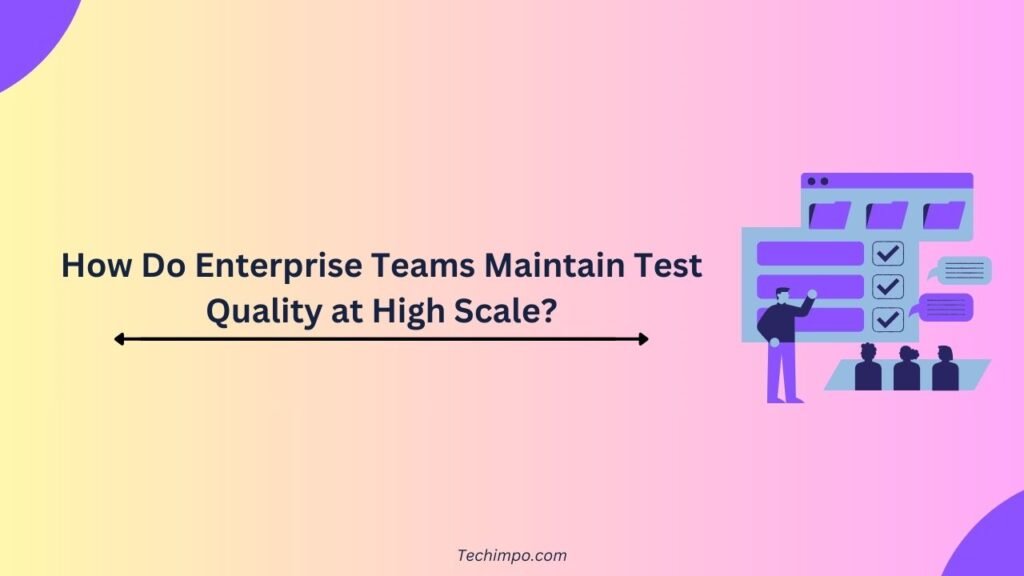General Overview of Large-Scale Enterprise Testing
Enterprise app testing is a lot of work, and it’s mostly because there are so many things that are in motion—several components, unlimited user scenarios, and all the functional and non-functional requirements to deal with. Teams need extensive test coverage in order to remain trustworthy, considering the apps are being deployed in so many various environments.
Test automation actually domesticates the mess. It decreases human effort, speeds up test execution, and makes it easy to identify issues early. Automated test suites allow teams to execute tests regularly, supporting fast integration and delivery and avoiding time-consuming errors of manual testing. Choosing a suitable automation framework and tools, which fit the app’s architecture and business needs, is a great thing in this case.
Performance and scalability testing are critical in enterprise scenarios where hundreds or thousands of users might converge simultaneously. They help locate bottlenecks and ensure that things are kept humming along under load. Test data management is also absolutely crucial, as it relies on it for the simulation of realistic users, and you need proper validation of what the system is doing.
Genuinely speaking, without close collaboration, enterprise testing would fail. Developers, testers, business analysts, ops people—they all must talk to each other, exchange priorities, and share test results. That’s how teams get better and better over time, tweaking test suites and processes as feedback and requirements arrive.
Good automation frameworks allow you to work with any kind of test data and scenarios without breaking a sweat. This maintains test durations low but coverage wide, crucial when release deadlines are always around the corner.
If communication is maintained in an ongoing manner throughout the DevOps pipeline, coordination simply happens automatically. Adding test automation to CI/CD pipelines is a paradigm shift toward fast, reliable software delivery. Automated pipeline tests catch problems early, so everyone isn’t surprised by yucky issues in production.
Expert test teams—security, performance, functional wizards—really set the bar high. Their experience creates test cases that mirror real user behavior and attacks, so the whole application is strengthened.
Cloud-based testing tools have also been a savior. They give teams scalable, malleable environments to run tests over all sorts of configurations, so you can see how the app will function wherever it’ll actually be deployed.
Managing legacy system integration is always tricky. It is difficult to test for compatibility without breaking something new with careful planning. Automated regression tests come in handy here, catching issues quickly when some change occurs in the old or new systems.
When teams can use automation for running tests, they get feedback faster and stay accurate. That speed enables products to reach markets faster, which is nigh on indispensable in today’s fast industries.
Purchasing these pieces in position helps organizations stay ahead of rising software complexity and high-quality. It also offers flexibility to the teams to transform as business needs and user needs shift.
Main Challenges in Maintaining Test Quality at Scale
Managing Giant Test Suites and Data Sets
With more test cases added in teams, it is hard to just keep the sheer quantity and the associated data with them. Large test suites slow everything down and are a pain to keep up with. Teams have to keep tests as lean and targeted as possible, which includes regular cleanup and smart prioritization. Scalable automation testing tools listed by Functionize can actually cut through the noise, enabling teams to maintain quality without falling behind.
Handling Multiple Platform Integration Complexity
Enterprise setups have a system of dependent systems and services. Testing all of these integrations involves orchestration—test data streams and environments need to be coordinated. When teams don’t manage dependencies correctly, flaky tests and strange outcomes begin popping up. So they must use strong approaches and integration-aware tools to maintain everything humming along just dandy all the way down the stack.
Strategies and Best Practices for Ensuring Test Quality
Scaled Test Automation
Testing at scale automation enables teams to cut down on manual work and retain coverage levels. The best automation frameworks follow reusable code, are part of CI pipelines, and focus on the most critical tests. Teams need to have these suites in maintenance and up to date, lest they will fall behind as the software advances.
Some good things to do
- Choose automation tools that actually fit into your technology stack
- Author test cases that are modular and easy to modify
- Execute tests regularly with rapid feedback planned
- Combine manual exploratory testing, where automation won’t be able to do everything
Effectively Managing Test Data
Good test data is the key to meaningful outcomes. Teams generally develop sample data sets, utilize synthetic data, and handle privacy within checks. Test data must be structured and versioned so tests become reproducible and things don’t vary by environment.
Best practices:
- Segment data by scenario and tabulate it neatly
- Anonymize or mask sensitive information for security
- Automatically set up and clean data to save time
- Track data quality—stale or inconsistent data can destroy results
Observability and Performance Monitoring
Watching test runs and product metrics enables teams to detect issues early on and decide whether or not things are worth fixing. Logging, metric, and alerting software give insights into test outcomes and app behavior. Observability also enables teams to make better, data-driven decisions about where to concentrate testing and resources.
Try these:
- Utilize dashboards to flag significant quality metrics
- Watch for trends in test failures or performance degradations
- Align test results with actual user experience metrics
- Let feedback constantly pass between developers and testers
Team Processes and Collaboration
High test quality at scale is not something a single individual can handle—good teamwork between functions is needed. Good communication and defined responsibilities avoid duplication and missed areas of coverage.
Teams with frequent retrospectives and feedback meetings can adapt flows as projects evolve. Tracking key testing and team performance indicators enables everyone to continuously improve.
Standardizing the manner in which teams work—frameworks, docs, automation—comes with consistency. Modular team structure helps too, giving autonomy, but also helps when needed.
The most crucial elements for healthy interaction and procedures are:
- Clear roles: Make sure everyone knows exactly what they own and what they’re accountable for.
- Communication rituals: Create regular check-ins and updates.
- Shared tools: Use platforms for test management, reporting, and code reviews that are shared with all.
- Scalable automation: Develop automated frameworks that scale with the team.
- Continuous learning: Encourage sharing and ongoing training to keep skills sharp.
This type of structure enables enterprise teams to keep quality high, even as things scale and become more complex.
Reasons for Choosing Enterprise-Level Application Testing
Businesses count on enterprise app testing to make certain that their complex systems work and stay secure, even amidst chaotic periods. Enterprise app testing guarantees apps adapt with business growth and everything runs smoothly between departments.
Most significant advantages are:
- Improved reliability: Finds bugs early to avoid disrupting the business
- Improved security: Identifies weaknesses in systems that handle sensitive information
- Performance validation: Ensures software can process heavy user loads and vast data without losing performance
- Scalability assurance: Ensures the application can perform more work as the business expands
- End-to-end coverage: Exercises end-to-end flows and integrations in disparate environments
By having a structured testing process, organizations can keep quality levels steady while releasing updates and changes throughout their software estate.
Plans for Upcoming High-Scale Test Quality
Enterprise teams are looking to improve test quality by automating more and implementing intelligent tools for coping with mounting software complexity. They’re trying to bridge the gap in continuous testing in Agile and DevOps environments, allowing feedback and bug detection earlier and sooner.
Upskilling testers is still a big priority—more advanced testing, increased automation skills, and more effective cross-remote team collaboration. Teams also want to improve the way they track coverage and handle defects, filling gaps and speeding up fixes.
Final Notes
Enterprise teams count on solid, scalable testing practices to keep quality up as projects grow. When you embed QA in CI/CD pipelines, you can release more quickly and reliably, and you don’t have to sacrifice test coverage. Automation is key here, but if you get it wrong, you’ll face consistency headaches, especially with big teams.
Shift-left testing lets people detect bugs sooner, which is less painful down the road and keeps everyone happy. Developers, QA people, and ops all need to work end to end—otherwise, things fall out of sync with what the business actually needs. And honestly, with software becoming more and more complex, it’s worth using advanced tools (even some AI-powered ones) to keep ahead of shifting requirements.
If you keep things in control of defects and follow standardized testing, you are able to continue high quality even during expansion. Ultimately, you have to test in a strategic and dynamic manner if you want your business to thrive in today’s world of rapid change.




